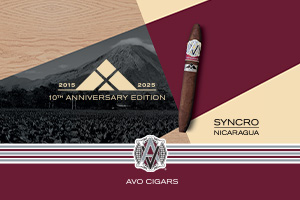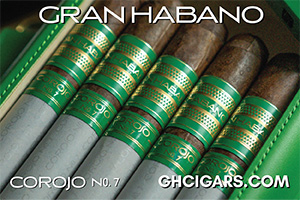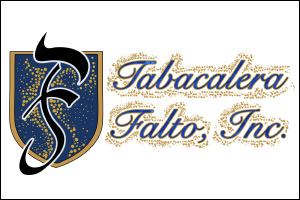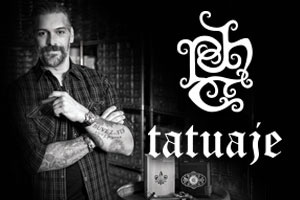Carnival La Vega, Dominican Republic
 Carnival is celebrated differently in the various cities of the Dominican Republic. The costumes are very different from city to city. So if you go make sure to check when the city you will be in celebrates. There are many characters of Carnival and a few of my favorites are the Roba la Gallina (Chicken Robber), Lechones and Diablo Cojuelos. Roba la Gallina (Chicken Robber) is a man dressed in brightly colored women’s clothing. He/she carries an umbrella and a purse and has a huge butt and breasts. Lechones (pig eaters) are one of my all time favorite.
Carnival is celebrated differently in the various cities of the Dominican Republic. The costumes are very different from city to city. So if you go make sure to check when the city you will be in celebrates. There are many characters of Carnival and a few of my favorites are the Roba la Gallina (Chicken Robber), Lechones and Diablo Cojuelos. Roba la Gallina (Chicken Robber) is a man dressed in brightly colored women’s clothing. He/she carries an umbrella and a purse and has a huge butt and breasts. Lechones (pig eaters) are one of my all time favorite.
Originally in Santiago the early masks were made from teeth, horns and hides which were leftovers from the slaughterhouse. The masks of today which use clay for the desired mold and layers of paper maché probably came with the Spanish colonizers centuries ago. Today’s artists have no boundaries when designing their masks and each one is more amazing then the next. One story is that the lechones originated as guardians during the Carnival of Santiago. They kept order by marching at the head of the parade, paving a path so that carnival characters could move through the crowd. They carried small staffs that they constantly waved back and forth. These were replaced by sisal rope whips, and later included rattles made of animal bladders.
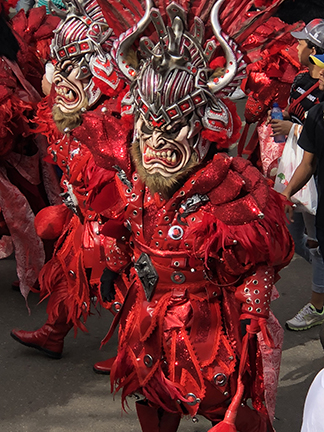 All lechones originally wore similar costumes but the rivalry between lechones brought about the need to differentiate between the neighborhoods. The masks from Los Pepines became known for their plain, very long, smooth horns with a mouth more like a duck bill. Those from La Joya were distinguished by their horns with spikes sprouting from them and longer pointy snouts. Another character, Diablo Cojuelos (Devil who walks with a limp) is from La Vega but you will see him in other regions with their own variations. The story is that he was a demon banished to earth because of his silly pranks. When he fell to earth he hurt his leg. He has multiple horns and a mouthful of big sharp teeth.
All lechones originally wore similar costumes but the rivalry between lechones brought about the need to differentiate between the neighborhoods. The masks from Los Pepines became known for their plain, very long, smooth horns with a mouth more like a duck bill. Those from La Joya were distinguished by their horns with spikes sprouting from them and longer pointy snouts. Another character, Diablo Cojuelos (Devil who walks with a limp) is from La Vega but you will see him in other regions with their own variations. The story is that he was a demon banished to earth because of his silly pranks. When he fell to earth he hurt his leg. He has multiple horns and a mouthful of big sharp teeth.
La Vega is known for the wilder experience. In Santiago the lechones pretend to snap the rope and hit people with the animal bladder but in La Vega I have been told that the lechones hit for real and it can be quite painful; I’ve even heard of people getting broken bones. The carnival in La Vega is said to be best observed from a safe place. It’s the contrary in Santiago where you are encouraged to participate in the festival.
We had only heard stories of La Vega. Its mysterious and dangerous nature of that particular carnival had our interest peaked. Throughout the years of going to the Dominican Republic people would tell us that we needed to experience carnival in La Vega, but it always came with a warning. During one of the nights at Procigar, we won an auction that included a dinner made and served by all of the Procigar members.
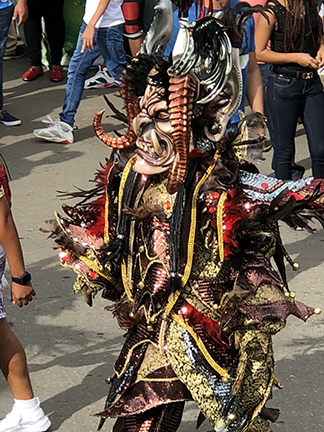 The Procigar team knew we had wanted to visit La Vega so as an added surprise they arranged a trip to carnival for us. They gave us access to one of “caves” so we could have a place to go if we needed a safe haven. It was hard not be excited for the dinner. That alone was a once in a lifetime opportunity. So adding La Vega made us that much more excited. The last weekend of carnival is always the biggest, as it’s the last carnival celebration of the year. The Procigar festival is usually timed around that weekend so we like to take advantage of the opportunity and stay when we can.
The Procigar team knew we had wanted to visit La Vega so as an added surprise they arranged a trip to carnival for us. They gave us access to one of “caves” so we could have a place to go if we needed a safe haven. It was hard not be excited for the dinner. That alone was a once in a lifetime opportunity. So adding La Vega made us that much more excited. The last weekend of carnival is always the biggest, as it’s the last carnival celebration of the year. The Procigar festival is usually timed around that weekend so we like to take advantage of the opportunity and stay when we can.
Years ago we featured carnival from the Dominican’s cigar capital, Santiago, as our cover feature story. It was our first experience with the Dominican Republic’s carnival outside of the Procigar festival itself. We learned about their carnival naturally by visiting the country on a regular basis and learning not only about cigar culture but the country as a whole. During various tours at the festival or at the dinners there would be performances and people dressed in these costumes. We knew right away we had to experience it firsthand. I remember we sat at a restaurant, cast in the shadow of the Monumento a los Héroes de la Restauración, in Santiago’s city center.
We had arrived early to find a high corner seat in the restaurant where we could see everything that was going on. It had multiple levels and was open aired. We were talking about what was to come in the hours ahead over a few Presidente beers. Originally we had hoped to be up on a platform watching the festivities. When the parade started our waiter told us “Go, go out into the parade that is the only way to feel it.” He only said it once and that was all it took for us to go and give up our seats. It was the best thing we could have done.
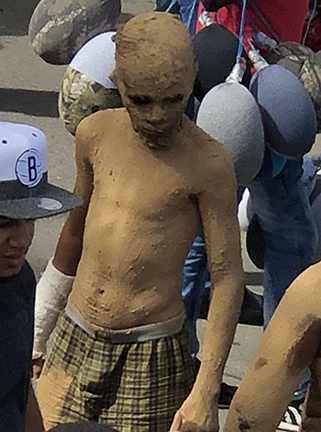 First we were watching everything on the stage but soon realized the parade went further so we followed it down the street. We were blown away while walking around. People filled the streets like sand on a beach. It was always an impressive experience to feel Santiago’s carnival. Never was it uncomfortable or dangerous feeling, but more communal with an overwhelming energetic spirit. La Vega however, must be like the death metal version of it from what we’ve heard, home of Diablo Cojuelos.
First we were watching everything on the stage but soon realized the parade went further so we followed it down the street. We were blown away while walking around. People filled the streets like sand on a beach. It was always an impressive experience to feel Santiago’s carnival. Never was it uncomfortable or dangerous feeling, but more communal with an overwhelming energetic spirit. La Vega however, must be like the death metal version of it from what we’ve heard, home of Diablo Cojuelos.
A van picked us and a few of our brave friends up after breakfast and we began the hour drive from Santiago to La Vega. When we arrived it was fairly early and still quite calm. Our driver didn’t speak English, but when we arrived and got out of the van he looked at us and said “quick.” and hurried forward. We zipped through the streets following him to the cave, which is basically a multilevel tent where you can watch the street and the individual teams that represent that particular cave, come in and out of. The caves are loud and sweaty, packed shoulder to shoulder. As the day passed it became busier and more intense both inside the caves and out in the actual parade.
Characters of all sorts were on the streets, in teams or as individuals. The main character that calls La Vega home is the Diablo Cojuelos. But it certainly wasn’t short of others like the Joker and other villainous characters throughout history, both fictional and real, armed with what were probably painted toy guns and the ferocity of those they portrayed. What else would you expect with a devil themed carnival where the gates of hell open allowing those to return? Nazi painted, German style cars, with Hitler and Stalin sitting side by side practically holding hands, waving to the audience and demon looking characters as far as the eye could see. People smeared head to toe in mud and oil would walk up to strangers and hold out a container for money. We didn’t see anyone refuse them.
 The Diablos and other characters would intimidate and surprise attack the unsuspecting. They would taunt those on the second levels of the caves, dancing, waving their weapons, eventually moving on. As the light in the sky began to settle, the crowds grew with the amplified music. There was no visible escape from the tent. With so much to see from the higher perspective and the loud crack of a whip followed by screams on the lower levels, we weren’t in a rush to head down. Eventually our time was up and we had to fight our way down and out to the street level, walking around a bit before having to get back in the van.
The Diablos and other characters would intimidate and surprise attack the unsuspecting. They would taunt those on the second levels of the caves, dancing, waving their weapons, eventually moving on. As the light in the sky began to settle, the crowds grew with the amplified music. There was no visible escape from the tent. With so much to see from the higher perspective and the loud crack of a whip followed by screams on the lower levels, we weren’t in a rush to head down. Eventually our time was up and we had to fight our way down and out to the street level, walking around a bit before having to get back in the van.
The Diablo Cojuelos were always my favorite masks and characters from the different carnivals. The variations and attention to detail on some of these costumes are truly incredible. They are works of art and it’s special to see them in action, outside of a museum wall. La Vega was a raw, unique experience, certainly raising more questions and the want to experience even more of it. If you’re into cigars, learning about the countries and cultures that they come from is taking the hobby to the next level. Visiting the Dominican Republic and Carnival should be on your checklist. Whether on your own or going to Procigar, you won’t be disappointed.






